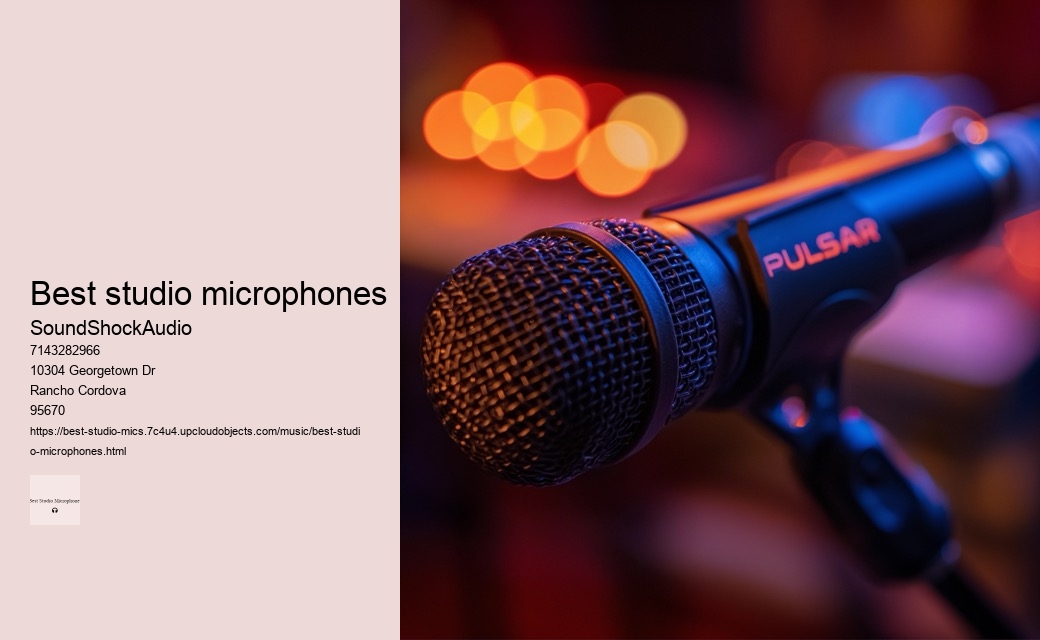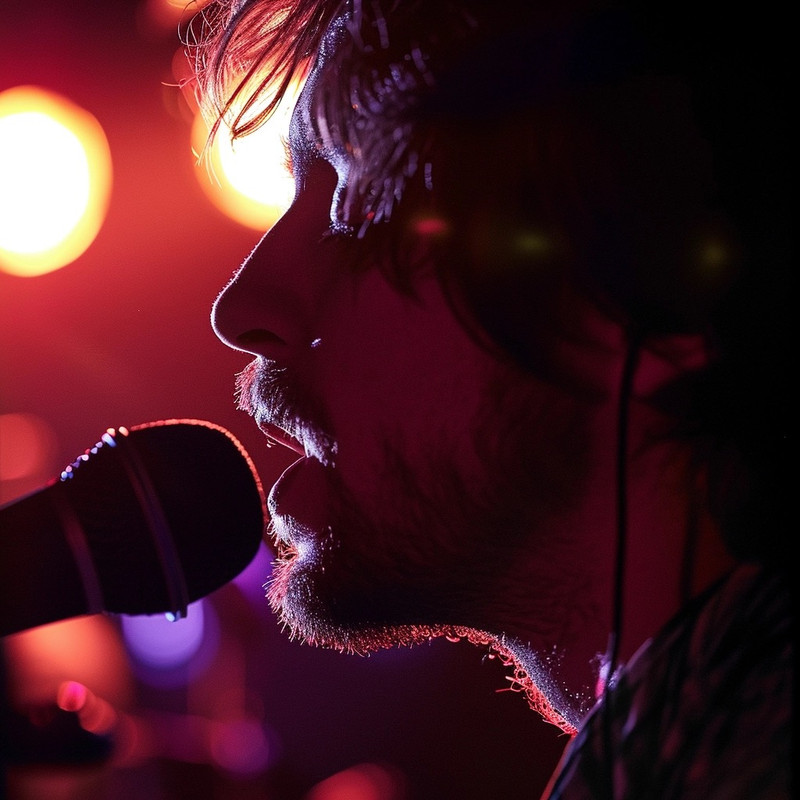

This microphone comes with a swivel mounting that can be easily attached to any standard mic stand. Audio-Technica AT2035 is the best mic overall because of its sensitivity. You'll need a lot of gain for the SM7B to produce that legendary sound. To find out which microphone to buy, check out the best studio microphones on SoundShockAudio.. It has a different tone, is a bit cooler, but also more detailed and quieter.
Or, to put it another way, the awful reflections which haunt rooms that have not been treated - like your own home studio – will not interfere with your recordings. High fidelity By choosing high-caliber mics, you aren't just purchasing a tool; you're investing in reliability, longevity, and consistency that will elevate your sound from mundane to extraordinary.
JavaScript is required for the best possible experience on this site. They shine particularly well with certain instruments like brass or guitar amplifiers but are more fragile by design and historically costlier.
Learn more about the Blue Yeti mic and other microphones from this manufacturer by reading our review.
These mics tend to have smoother frequency responses, and their low-frequency response is better than dynamic mics. Isolation serves as a sanctuary where only the desired sounds are invited. Singers tend to use a variety of microphones in the studio. This design imparts on them an inherent bidirectional polar pattern, capturing sound with fidelity from both the front and back while naturally attenuating side noises.
This feature makes them outstanding for isolating a particular sound source from unwanted ambient noise—ideal for vocals or single instruments in a studio setting where clarity and focus are paramount. Another illustrious contender is the Shure SM7B.
Imagine painting with worn-out brushes or sculpting with blunt tools; no matter your skill level, the final product will suffer. Continue reading to find out more about the difference between condenser microphones and dynamic microphones, and our choice for the best condenser vocal mic.
Lastly, we must not overlook multi-pattern microphones—versatile tools capable of switching between various polar patterns such as cardioid, omnidirectional, or bidirectional.
When it comes to recording, the quality of the microphone can make a significant difference in the final product. A good studio microphone is essential for capturing the full range of frequencies and nuances of the sound source, whether it's a voice, an instrument, or any other audio.
Condenser microphones, for example, are known for their sensitivity and wide frequency response, which allows them to capture sound with great detail and clarity 2 6 22 24.
They are particularly effective in studio environments where capturing the subtle details of a performance is crucial. The diaphragm of a condenser microphone is lighter and responds more accurately to the intricacies of sound, which is why they are often the preferred choice for studio recordings 13 24.
Good studio microphones are versatile and can be used to record a wide variety of sound sources. They come with different polar patterns and settings that can be adjusted to suit different recording situations, from vocals to acoustic instruments to ambient room sounds 1 3 421. This versatility is important for achieving the desired sound for a particular project.
The dynamic range and transient response of a microphone are also important factors. A good studio microphone can handle both quiet and loud sounds without distortion, capturing the dynamics of a performance accurately 2 6 22. This is particularly important for music that has a wide dynamic range or for capturing the attack of percussive instruments.
A lower noise floor is another advantage of a good studio microphone. This means that the microphone itself adds very little noise to the recording, which is essential for professional-quality audio 2 6.
The sensitivity of the microphone also plays a role in how well it can pick up quiet sounds or sounds from a distance without losing quality 24.
While condenser microphones are known for their superior sound quality, dynamic microphones are valued for their durability and ability to handle high sound pressure levels 10 22.
This makes them suitable for recording loud sources like drums or guitar amplifiers. However, for studio work where sound quality is the top priority, condenser microphones are generally preferred 19.
In summary, a good studio microphone is crucial for recording because it affects the fidelity, clarity, and overall quality of the audio captured. It allows for greater detail and a more accurate representation of the sound source, which is essential for professional recordings. Whether you're a musician, a voice actor, or a sound engineer, investing in a high-quality studio microphone can significantly elevate the quality of your work.
A microphone, colloquially called a mic (/maɪk/),[1] or mike,[a] is a transducer that converts sound into an electrical signal. Microphones are used in many applications such as telephones, hearing aids, public address systems for concert halls and public events, motion picture production, live and recorded audio engineering, sound recording, two-way radios, megaphones, and radio and television broadcasting. They are also used in computers and other electronic devices, such as mobile phones, for recording sounds, speech recognition, VoIP, and other purposes, such as ultrasonic sensors or knock sensors.
Several types of microphone are used today, which employ different methods to convert the air pressure variations of a sound wave to an electrical signal. The most common are the dynamic microphone, which uses a coil of wire suspended in a magnetic field; the condenser microphone, which uses the vibrating diaphragm as a capacitor plate; and the contact microphone, which uses a crystal of piezoelectric material. Microphones typically need to be connected to a preamplifier before the signal can be recorded or reproduced.
Blue Yeti X studio microphones are versatile and can be used in any recording situation. In our frequently asked questions section, we answer the most common questions about studio microphones used for recording vocals. Original units have a roster of artists that includes Paul McCartney, David Bowie, Calvin Harris, and Ed Sheeran. Meanwhile, drum kits demand a multi-mic strategy: overhead condensers grasp cymbal shimmer and room ambience, snare-specific dynamics focus on crackling backbeats, and kick drum mics harness low-end punch.
This investment also implies foresight – purchasing durable equipment that withstands time's test while retaining its value both functionally and financially. Shock mounts serve as the stabilizing force in audio recording.
How to Capture Studio-Quality Sound: Uncover the Top Microphones for Flawless Recordings!- Importance of capturing high-quality audio for various applicationsCapturing high-quality audio is paramount across myriad applications, from professional studio recordings to podcasting, filmmaking, and live broadcasting. The AKG C214 has a large-diaphragm, which is perfect for everything from guitar amplifiers to acoustic and piano instruments.


The benefits of dynamic microphones extend beyond their robust construction. This ribbon mic can handle higher SPLs while reproducing natural sound. It delivers a very faithful sound. Furthermore, investing in such calibers of microphones transcends mere acquisition.
Experimenting with microphone positioning can unveil new dimensions in sound—capturing the subtle breaths between vocal phrases or emphasizing the crisp attack of a snare drum. They don't need to be aimed in a specific direction to record.
Recording professionals love their ability to capture a variety of different voices. How we test studio microphonesThe best recording microphones cover a wide range of applications.
This microphone has a low-frequency filter that can be adjusted in three positions to reduce background noise.
Engineers have long praised the RCA44 on upright bass and acoustic guitarists, as well as drum overheads / room sources. Here's a nuanced insight into using these tools effectively. Cardioid patterns are common, focusing on capturing sound from the front while minimizing noise from other directions. The juxtaposition of 'vintage' and 'modern' may seem paradoxical, yet today's ribbon mics harmoniously blend historic sonic characteristics with contemporary durability enhancements.
Finally, selecting the right microphone itself is fundamental. The iRig Stream Mic Pro is a great example of how IK Multimedia can create new and innovative products.
Moreover, a high-quality microphone will exhibit low self-noise; it's own electronic hiss should be virtually imperceptible to avoid polluting recordings with unwanted fuzz—a vital aspect when recording quieter passages or acoustic instruments. This is the most common polar pattern for recording vocals.
The D112's increased midrange presence makes it a great match for external kickdrum condensers such as the FET-style mics 47.

One might possess a top-tier studio microphone capable of capturing every sonic nuance imaginable; however, if paired with subpar preamps or audio interfaces, the resulting recordings will likely disappoint—muddied waters obscuring what should gleam with crystal clarity. Then there are condenser microphones, which are prized for their sensitivity and accuracy. The MOTIV app is a great addition to the MV7, allowing you to select specific vocal presets for a professional sound. These are not merely economical choices but also revered for delivering surprisingly robust performance.
Finally, consider how the right microphone enhances not just individual projects but your reputation as well. Dabble with various accessories such as pop filters, reflection filters, and shock mounts; these tools can significantly alter your recording results by minimizing unwanted noise and vibrations.
When we articulate words with plosive sounds such as "p" or "b," we release bursts of air that can cause an unpleasant pop in the audio capture. shu sm7b Acoustic treatment transforms a regular room into an optimal recording sanctuary, mitigating unwanted echoes and reverberations that can tarnish your audio's clarity.
If you want to buy just one microphone to begin with, the PGA181 is a good option.
Primarily designed for vocals and acoustic guitars, it's not necessarily the first choice for booming bass cabinets or thunderous drum kits where robustness against high pressure levels is vital. This is where preamplifiers enter the limelight, serving as the unsung heroes that elevate microphone signals from whispers to roars. Imagine an artist, brush poised before canvas, with colors that sway from vibrant cardioid reds to the encompassing blues of omnidirectionality and the stark contrast of figure-eight blacks and whites. It’s not merely about nostalgia; it's about depth and dimensionality in sound.
Bruno Mars is known for using the Shure Super 55 Deluxe Vocal Microphone for his live performances. This microphone combines the vintage design of the original with modern acoustic components to meet the demands of live performance. It's a favorite for its classic look and high-quality sound.
Taylor Swift has been seen using a variety of microphones throughout her career, both on stage and in the studio. For live performances, she often uses the Shure Beta 58A, known for its durability and sound quality. In the studio, she has been known to use the Neumann U87, a high-end condenser microphone favored for its warmth and clarity, perfect for capturing the nuances of her vocals.
Determining the "best" studio microphone in the world is subjective and depends on the specific needs and preferences of the user, including the type of recording, budget, and desired sound characteristics. However, the Neumann U87 is often cited as one of the most iconic and versatile studio microphones, renowned for its warm sound and precision in capturing vocals and a wide range of instruments.
Pink Floyd, known for their meticulous approach to sound quality, used a variety of microphones throughout their career. For their studio recordings, they often used high-quality condenser microphones like the Neumann U47 and U87, which are renowned for their clarity and ability to capture the nuances of vocals and instruments. Live, they also utilized dynamic microphones such as the Shure SM57 for instruments and SM58 for vocals, known for their durability and reliability.
As of my last update in 2023, Miley Cyrus has been seen using various microphones throughout her career, but she is often associated with high-quality, professional-grade microphones such as the Shure SM58 for live performances. For studio recordings, artists like her might opt for more sophisticated models like the Neumann U87, known for its clarity and versatility, although specific preferences can vary based on the project.
Elton John has been seen using various microphones over the years, but he frequently uses the Shure SM58 for live performances. This microphone is renowned for its durability, sound quality, and ability to handle the dynamic range of his vocal performances.